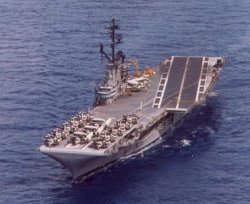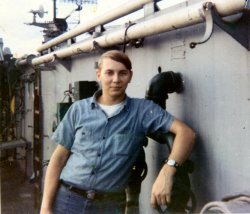|

 In late 1969 the U.S.S. Yorktown, a World War II-vintage Essex-class aircraft carrier, was being used by the United States Navy to keep an eye on the Soviet Union's submarine fleet in the North Atlantic and other bodies of water adjacent to Western Europe. In late 1969 the U.S.S. Yorktown, a World War II-vintage Essex-class aircraft carrier, was being used by the United States Navy to keep an eye on the Soviet Union's submarine fleet in the North Atlantic and other bodies of water adjacent to Western Europe.
At this time, the war in Vietnam was receiving the lion's share of media attention. Consequently, most Americans, including (probably) sailors serving aboard the Yorktown, were distracted from the fact that it was not a re-unified Communist Vietnam that posed the greatest threat to the security of the United States but rather the Soviet Navy's SLBMs (Submarine Launched Ballistic Missiles).
 In 1969, I was one of those sailors and I regret that it was not until more than three decades later that I began to fully comprehend the scope and importance of the service that my shipmates and I rendered to the nation--a service that I and probably most of my shipmates took for granted. Owing to its seemingly routine nature and also because Vietnam was getting all the attention at the time, I don't think our contribution was ever fully appreciated by the American people either--and probably still isn't. What I am suggesting then is that Cold War veterans are just as deserving of recognition as those who served in Korea or Vietnam. Consequently, I think it is a situation that needs correcting--and what better way to do it than through websites such as this one? In 1969, I was one of those sailors and I regret that it was not until more than three decades later that I began to fully comprehend the scope and importance of the service that my shipmates and I rendered to the nation--a service that I and probably most of my shipmates took for granted. Owing to its seemingly routine nature and also because Vietnam was getting all the attention at the time, I don't think our contribution was ever fully appreciated by the American people either--and probably still isn't. What I am suggesting then is that Cold War veterans are just as deserving of recognition as those who served in Korea or Vietnam. Consequently, I think it is a situation that needs correcting--and what better way to do it than through websites such as this one?
By the time I served aboard the Yorktown, she was more than twenty-six years old, originally commissioned in 1943 to replace another carrier also named Yorktown, which was sunk by the Japanese at the Battle of Midway in 1942. Five years later, after racking up a distinguished war record, the then relatively new Fighting Lady (as she is also known) was retired. She was re-commissioned in 1953 as an attack carrier (CVA-10), then finally, converted for use as an ASW (Anti-Submarine Warfare) carrier (CVS-10) in 1957. Throughout her long career, which included operations off the coast of Vietnam and serving as a recovery vessel for the Apollo 8 spacecraft (in 1968), Yorktown operated primarily in the Pacific. She did not reach her new Atlantic homeport of Norfolk, Virginia until early 1969.
On 2 September 1969, the Yorktown departed Norfolk for the "twilight cruise" this website commemorates. Owing to the fact that I was being transferred from shore duty to sea duty at the time and had taken two weeks leave in-between, I did not actually join the ship until it was about mid-way through its three-month deployment. After first spending three of the most miserable weeks of my life (apart from boot camp) in the transient barracks at Norfolk and then one, much more enjoyable week in London, England, I eventually reached the ship on 16 October, shortly after it arrived at Rotterdam, in the Netherlands.
Only two days after I went aboard, I was one of several hundred Yorktown crewmen left behind when the ship left port unexpectedly as part of an operational readiness drill. To learn more about my adventures and how I eventually made it back aboard, read PERSONAL NARRATIVES.
Two things inspired this website and its companion--"CARRIER 1971." One was the recent realization that more than forty years had passed since I enlisted in the Navy. The other was the recently-aired PBS television documentary series, "CARRIER," which tells the story of the crew of the U.S.S. Nimitz as they go on a six-month deployment to the Middle East, transiting the Pacific and Indian oceans.
What struck me, as I watched the "CARRIER" series, was not so much the many things that have changed (such as women now serving aboard ship) but rather the things that remain the same. For instance, although sailors today have email and on-board pay phones to keep in contact with family and friends, they still look forward to mail call. I also noticed that the flight deck is still a dangerous place to be during "ops," that port calls are still eagerly anticipated, and that a huge difference in outlook remains between "lifers" (career sailors) and those who can hardly wait for the day their enlistment expires. (I admit that I was myself one of the latter.)
I want to make it clear that the purpose of this site is not to glorify war or to glamorize military life but rather to share my recollections of one of the most memorable events in my life as well as to show what life was like as part of a carrier crew operating in the North Atlantic (and several other bodies of water) during the Cold War. I am a historian "by trade" and therefore I have taken a historical approach toward this project. In any event, I hope you both enjoy and learn from it.
A word about the images on this site: Many are either personal photographs or pictures I created using image editing software. One example is the carrier at the top of the page, which was made from an official U.S. Navy photo of the Yorktown. For all original images I claim copyright, which means they may not be used without permission (but don't be afraid to ask!). Other images, such as the flag divider near the bottom of this page, are freely distributed on the Internet. Of course I do not claim copyright on the emblem in the center of the home page, which was scanned from my Yorktown belt buckle, or any photos scanned from my U.S.S. Yorktown 1969 cruise book, because they were taken from a U.S. Government publication on which there is no copyright.
Finally, an acknowledgement: The lady in the photo below is my still lovely wife--the same English "bird" I met during the week I spent in London prior to catching up with the Yorktown in Rotterdam and the very same girl who I not only saw again in England before the ship returned to the U.S. but who also agreed to marry me less than a year later. For this reason, I have always thought of the last cruise of the U.S.S. Yorktown as the "cruise that changed my life." And I am happy to report that it was a change for the better!

-- Steven R. Butler, Ph.D. (formerly PR3, VS-24)
|

![]()
 Purchase
Purchase Purchase
Purchase In late 1969 the U.S.S. Yorktown, a World War II-vintage Essex-class aircraft carrier, was being used by the United States Navy to keep an eye on the Soviet Union's submarine fleet in the North Atlantic and other bodies of water adjacent to Western Europe.
In late 1969 the U.S.S. Yorktown, a World War II-vintage Essex-class aircraft carrier, was being used by the United States Navy to keep an eye on the Soviet Union's submarine fleet in the North Atlantic and other bodies of water adjacent to Western Europe. In 1969, I was one of those sailors and I regret that it was not until more than three decades later that I began to fully comprehend the scope and importance of the service that my shipmates and I rendered to the nation--a service that I and probably most of my shipmates took for granted. Owing to its seemingly routine nature and also because Vietnam was getting all the attention at the time, I don't think our contribution was ever fully appreciated by the American people either--and probably still isn't. What I am suggesting then is that Cold War veterans are just as deserving of recognition as those who served in Korea or Vietnam. Consequently, I think it is a situation that needs correcting--and what better way to do it than through websites such as this one?
In 1969, I was one of those sailors and I regret that it was not until more than three decades later that I began to fully comprehend the scope and importance of the service that my shipmates and I rendered to the nation--a service that I and probably most of my shipmates took for granted. Owing to its seemingly routine nature and also because Vietnam was getting all the attention at the time, I don't think our contribution was ever fully appreciated by the American people either--and probably still isn't. What I am suggesting then is that Cold War veterans are just as deserving of recognition as those who served in Korea or Vietnam. Consequently, I think it is a situation that needs correcting--and what better way to do it than through websites such as this one?